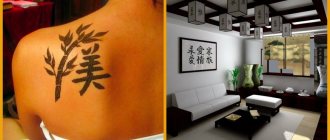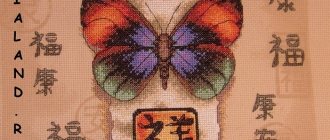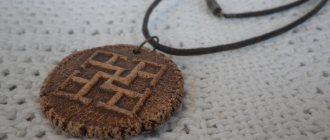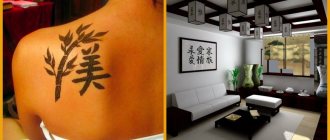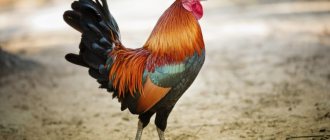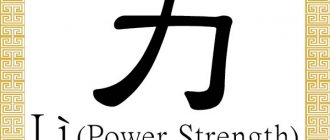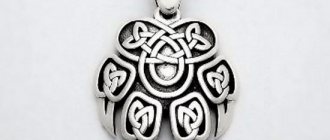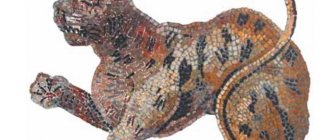Chinese and Japanese characters always carry a semantic load, reflecting individual meaning and purpose. Residents of these Asian countries endow each such symbol with special energy in order to get the desired result and fulfill their own dreams.
An important character in Japanese and Chinese writing is “strength,” which is of great importance to the people of China and Japan. These symbols are considered favorable and happy in both countries, but this sign must be used carefully so as not to upset the energy balance.
Chinese character strength
It is considered a talisman that can fill a person with wisdom, vitality and strength. It also improves physical and mental well-being, gives a feeling of power and unlimited possibilities, and self-confidence. Thanks to the close location of the hieroglyph “strength,” a person’s ambitions and desires will constantly grow, new ideas will be born, and creativity will skyrocket.
This hieroglyph has a special influence on athletes, creative individuals, and businessmen, charging them with the energy of victory. Always helps when concluding deals, at meetings, creative competitions, and competitions.
The hieroglyph must be placed so that it is always with the person and in sight. It is best to tell it in the zones of fame (south), wealth (southeast) and career (north).
Used in meanings such as:
- Energy or force energy 能源动力.
- To influence something, to use force 他施加力到它.
- Ability, including the ability for music 在音乐的能力.
- Domestic violence 家庭暴力.
- Study hard 努力学习.
The pictogram is suitable for residents of large cities who lead an active lifestyle and are tired of city noise. They constantly need to restore energy in order to fill their body with health and strength, help them spread their wings, grow in their careers, stabilize life processes, build and implement plans.
You should not combine it with other hieroglyphs, so as not to harm yourself, your loved ones, desires and ideas.
Description
Consists of one hieroglyph, which consists of two small lines. This hieroglyph is located in the dictionary under number 19.
It is denoted by 力 and can be used as part of various phrases, in complex hieroglyphs and can act as a separate grapheme. Placed in different parts of complex structures.
Writing rules
The character 力 is a pictogram that depicts a person bending down. This is how he lifts an object using muscle power. The vertical line 丿 is the meaning of a hand, a hook that is curved down like a brush.
Sometimes the pictogram is interpreted as a plow, i.e., a heavy tool that requires physical strength to use. Agriculture has always played and continues to play an important role in the life of the Chinese, which is why they invented a special sign to represent the plow and physical strength.
How to read
It must be pronounced in tone No. 4. It is read as “li.”
Chinese writing and its influence
The Chinese writing system has a very important cultural significance due to its wide distribution and high status. Different dialects, even different languages, used Chinese characters as a common writing system. In the Middle Ages, in Korea and Vietnam, as well as on the Japanese islands, Chinese pictograms were the only official writing system.
Thanks to the independence of reading and writing Chinese characters, it is relatively easy for other ethnic groups to use them. For example, in Japan, the Korean state and Vietnam they did not speak Chinese, but exclusively used the Chinese method of writing characters. This played a significant role and made it possible to unite into a single nation a large number of dialect speakers who had difficulty speaking with each other. Of course, it was convenient to divide all pictograms into simple wen 文 and complex zi 字.
Japanese character strength
According to the accepted version, hieroglyphs were brought to Japan by Buddhist monks. Chinese writing was successfully assimilated on the islands, since the Japanese did not have their own writing at that time. Then their own Japanese characters appeared, based on Chinese pictograms. The sign for “strength” in Chinese and Japanese is identical, only the spelling differs.
Examples of usage in the literal sense:
- Physical strength - 体力 (kanji - tairyoku).
- Rickshaw – 人力車 (jinrikishya).
- strength, power – 強力 (kyou:ryoku).
In other meanings:
- Effort or effort – 努力 (doryoku).
- Ability and skill – 能力 (no:ryoku).
- Cooperation – 協力 (kyou:ryoku).
Description
The first part denotes spirit, mood and disposition, soul. The second part is interpreted as power, strength, both physical and spiritual, moral. Therefore, the pictogram is also translated as “strength of spirit.”
Writing rules
The pictogram 刀 (chikara) is written with two dashes, which can be found in other Japanese words. The kanji for "strength" can also be written as ryoku, riki.
Features of Chinese characters
Each character in the Chinese language has its own specific meaning and semantic load, which are closely related to other features of this writing system. These complex symbols have enormous energy, which in reality can help achieve the desired results and implement all plans. The Chinese character for "strength" is an auspicious and positive pictogram. These symbols must be used with caution, since each sign in Chinese writing has an ambiguous and specific meaning, which is often understandable only to native speakers, professional linguists and philologists.
Mystical hieroglyphs
In tattoo parlors, Japanese signs are in demand, which denote worldview, lifestyle, and mystery.
Such as:
- Karma - according to Buddhist philosophy, it depends on what actions its owner committed, righteous or sinful.
- Eternity - in its outline, this hieroglyph is very similar to the sign for “water” due to the fact that the Japanese personified its flow over time.
- Eternal wandering - this phrase consists of four hieroglyphs, in which the sign of eternity is also based on the symbol of water. At the very bottom of the inscription there is a red calligraphic seal of the author.
- Emptiness is a hieroglyph that is quite rich in meaning, despite the first impression of the meaning of this word. Denotes attachment to illusory things that have no real value.
Composition and color scheme
Japanese hieroglyphs for tattoos are usually done in black. But there are also symbols using 5 primary colors, each of which carries a specific meaning.
| Color | Meaning |
| Blue-green | In Japan it is a single color and is represented by the word "aoi". It represents the wind and is considered the most fickle element, which can embody both the calmness of the sky and trees, and the destructive power of a hurricane. |
| Red | Symbolizes fire, sun, energy and development. According to the Japanese, this color protects from evil and brings joy, tranquility, and good luck to the home. |
| Yellow | Associated with earth, gold, constancy and prosperity. |
| White | The most controversial in the Japanese color scheme. It simultaneously personifies both mourning and a talisman against the other world. |
In tattoos, the above-mentioned shades are used to give greater expressiveness and energy. For example, to increase its favorable meaning, the hieroglyph is outlined with a red line. You can make the tattoo unusual and original by carefully inscribing the symbol into any pattern or image.
Keys in hieroglyphs
As could be understood from the analysis of the composition of some of the hieroglyphs above, simple symbols can be part of complex ones (for example, strength and courage 力 and 勇). Chinese characters are classified according to elements that classify a word into the category of some objects or concepts, that is, according to keys.
In total, in the traditional system there were 214 such “keys” (they are also called radicals), in the modern version there are 201. The radicals “man” 人 and “strength” 力 were often found in symbols for tattoos. You can find the symbols in the summary table of hieroglyphs.
Reasons for the popularity of hieroglyphs for tattoos
Japanese hieroglyphs for tattoos in Russia have spread relatively recently.
They have become quite popular due to the rich history and unique culture of Japan. Such painting on the body is incredibly beautiful, and with the help of skillfully applied marks you can tell a lot about yourself. Experienced artists make sure that a tattoo in the form of a hieroglyph is not just a beautiful picture, but carries a deep meaning. The meaning of such drawings is so diverse that almost anyone can choose an image that suits them.
Features of tattooing in the form of hieroglyphs
Abundance. Chinese tattoo hieroglyphs, which help to attract something or protect from something, are extremely popular. And the hieroglyph meaning abundance breaks all records. Even among the Chinese, wealth is one of the main wishes for the holidays.
The hieroglyph consists of such parts as “house”, “mouth” and “field”. That is, shelter, food and a source of food. Basic needs are what the Chinese understand as abundance.
The hieroglyph that illustrates wealth is perfect for a
Buddha tattoo. An extremely strong person in Chinese culture and therefore a powerful talisman. His interpretation is curious - Buddha consists of the element “man” and the particle “not”. That is, divine origin is emphasized. It is believed that the talisman helps to improve oneself and find enlightenment.
We invite you to familiarize yourself with: Meditations “Opening the flow of love” by Klaus Joule: technique of sending love and other practices from the author || Sending love to Klaus Joel
Hieroglyph tattoo in the form of Buddha
Longevity. One of the most important wishes of the Chinese. It is interesting that this hieroglyph comes from the word “field”. Then the "elderly" icon was added. The eastern people were sure that doing manual labor and eating natural food was the key to long life.
Talisman tattoo meaning longevity
Luck. This hieroglyph consists of the symbols "sage" and "speech". In other words, luck is not just fatalism, luck. This is working on yourself. And the ability to listen to the sages, the desire to follow their advice.
Hieroglyph tattoo meaning good luck
Bull. Chinese tattoo hieroglyphs, symbolizing the zodiac year of birth, are in demand. In addition, they are symbolic in themselves. Thus, the bull is the real embodiment of masculinity.
Bull hieroglyph for tattoo
The Dragon. The Chinese have revered this mythical creature for about 6,000 years. According to beliefs, this sign gives its owners the ability to get out of difficult situations and wisdom.
Hieroglyph tattoo dragon
Snake. She is also wise. It also symbolizes rebirth - it’s not for nothing that the snake is a medical emblem. Suitable for inquisitive natures.
Hieroglyph snake tattoo
Boar. Hieroglyph for born leaders. They are brave and know how to captivate people. The wild boar is also associated with fertility.
Hieroglyph tattoo pig
Rabbit. A symbol of both innocence and sexuality. The Chinese claim that this astrological sign is the happiest of all signs.
Hieroglyph tattoo in the form of a rabbit
Rat. A nimble, fast and agile animal that conveys its qualities to a person born under this sign. The hieroglyph will perfectly help entrepreneurs, giving them unprecedented flair.
Tattoo hieroglyph with the designation of a rat
Horse. The hieroglyph will help develop intelligence and help you make the most of your mind. It is believed that a person with such a talisman makes the right decisions faster.
Horse hieroglyph tattoo
Sheep. This animal gives the most pleasant emotions, and always. The hieroglyph also helps its owner become a source of positive emotions. Tattoo wearers are kind and sincere.
Hieroglyph for a sheep tattoo
Monkey. The hieroglyph gives a wonderful sense of humor, intelligence, and organization. Thanks to such a talisman, a person strengthens his memory.
Hieroglyph tattoo monkey
Rooster. Symbol of rebirth, the sun. The hieroglyph also indicates that a person is able to start something new. It is considered a harbinger of success and useful achievements.
Hieroglyph tattoo Rooster
Dog. One of the most popular hieroglyphs. Associated with loyalty, the ability to provide protection to other people. The tattoo also protects its owner.
Hieroglyph dog tattoo
Tiger. The Chinese love this symbol. This is a real emblem of a warrior - a man who is fierce, but ready to rush to the rescue. The hieroglyph helps its owner move rapidly through life.
Hieroglyph tattoo tiger
Chinese is one of the most ancient languages in the world. Samples of its writing date back to the 4th century BC! It is not surprising, therefore, that a huge number of tattoo fans dream of capturing something in this language. We hope that our examples will inspire someone.
The key point before applying a hieroglyph to the body is to carefully study its meaning and combination with other signs. Using a symbol incorrectly can lead to its opposite meaning or leave the tattoo owner with a stupid or indecent message.
Therefore, before contacting a master, you need to consider the desired design in detail and clarify its content in specialized literature or from people who know Japanese calligraphy. You should not shift all responsibility for the concept of such a tattoo to the tattoo artist.
